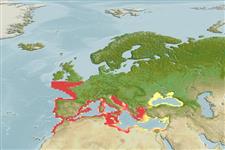Environment: milieu / climate zone / profondeur / distribution range
Écologie
marin démersal; profondeur 10 - 400 m. Subtropical; 51°N - 30°N, 11°W - 42°E
Southeast Atlantic: Atlantic coast from Morocco to the English Channel. Also known from the Mediterranean and Black Sea.
Length at first maturity / Taille / Poids / Âge
Maturité: Lm 10.0 range ? - ? cm
Max length : 20.0 cm TL mâle / non sexé; (Ref. 3397)
Épines dorsales (Total) : 11 - 12; Rayons mous dorsaux (Total) : 14 - 16; Épines anales: 2; Rayons mous anaux: 15 - 16. Gill membranes not forming a fold across isthmus. Tentacles on nasal opening, above eye and on nape near first dorsal fin ray. Dentaries joined by suture. Lateral line reduced, discontinuous. Anterior part of dorsal fin conspicuously higher than posterior part.
Body shape (shape guide): elongated.
Adults are found over hard bottoms. Mainly nocturnal, they feed on small invertebrates. Oviparous. Eggs are demersal and adhesive (Ref. 205), and are attached to the substrate via a filamentous, adhesive pad or pedestal (Ref. 94114). Eggs are laid under mussel-shells or stones and guarded by the male (Ref. 5981). Larvae are planktonic, often found in shallow, coastal waters (Ref. 94114). Spawn in April (Marseille) or July (England) (Ref. 5981).
Eggs are laid under mussel-shells or stones and guarded by male (Ref. 5981).
Wheeler, A., 1992. A list of the common and scientific names of fishes of the British Isles. J. Fish Biol. 41(suppl.A):1-37. (Ref. 5204)
Statut dans la liste rouge de l'IUCN (Ref. 130435: Version 2025-1)
Menace pour l'homme
Harmless
Utilisations par l'homme
Pêcheries: intérêt commercial mineur
Outils
Articles particuliers
Télécharger en XML
Sources Internet
Estimates based on models
Preferred temperature (Réf.
123201): 11 - 17.1, mean 13.9 °C (based on 237 cells).
Phylogenetic diversity index (Réf.
82804): PD
50 = 0.7500 [Uniqueness, from 0.5 = low to 2.0 = high].
Bayesian length-weight: a=0.00851 (0.00660 - 0.01098), b=3.02 (2.94 - 3.10), in cm total length, based on LWR estimates for this species (Ref.
93245).
Niveau trophique (Réf.
69278): 3.5 ±0.43 se; based on food items.
Résilience (Réf.
120179): Milieu, temps minimum de doublement de population : 1,4 à 4,4 années (Preliminary K or Fecundity.).
Fishing Vulnerability (Ref.
59153): Low vulnerability (10 of 100).
🛈
Nutrients (Ref.
124155): Calcium = 80 [19, 235] mg/100g; Iron = 1.14 [0.42, 4.30] mg/100g; Protein = 3.21 [0.00, 6.94] %; Omega3 = 0.348 [0.150, 0.795] g/100g; Selenium = 23.3 [4.9, 67.0] μg/100g; VitaminA = 18.7 [6.0, 56.8] μg/100g; Zinc = 0.869 [0.449, 1.739] mg/100g (wet weight);
